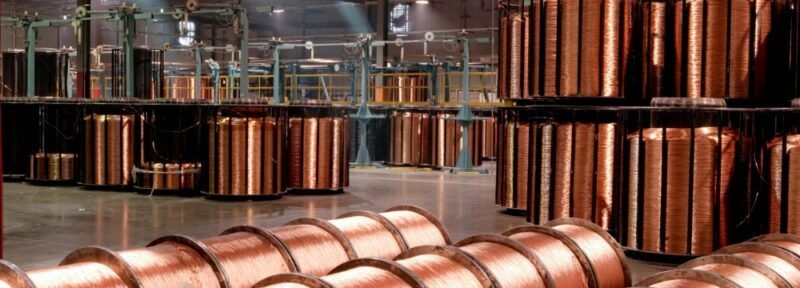Since March, The price of Copper, which is used in everything from power systems and air conditioners to computer chips and Electric Motors, has been decreased. Investors are dumping stocks out of concern that a worldwide economic downturn will reduce demand for a metal associated with expansion and growth. Although you wouldn’t know it by looking at the market right now, Some of the biggest miners,. And metals traders are warning that in just a few years. A massive shortage for the world’s most important metal will arise. This shortage could itself impede global growth,. Fuel inflation by driving up manufacturing costs, and sabotage efforts to reduce greenhouse gas emissions. The recent downturn and the ensuing underinvestment only hold the potential to exacerbate the situation.
The current decline in copper prices only serves to make the impending shortfall worse by discouraging new investments in the metal. Which is used in electric vehicles and in power systems.
An analyst of statistics Comments “The market is simply reflecting the current worries. But if you gave the future some serious thought, you’d realize how drastically things have changed. It will be electrified, and a lot of copper will be required”.
Copper Mining
Trading exchanges are monitoring inventories that are close to historical lows. And given the recent price volatility, it’s possible that new mine output,. Which is already anticipated to begin to decline in 2024. Will become even more constrained soon. A $2 billion gold and copper project in Peru was recently shelved by the world’s largest mining company, Newmont Corp. The largest publicly traded supplier of copper in the world has issued a warning. That current pricing are “insufficient” to finance further developments. For months, if not years, commodities experts have been predicting a probable copper shortage. The most recent market slump also has the potential to make future supply issues worse by giving consumers a false sense of security, stifling cash flow, and deterring investments.
The decisions producers make now will influence supplies for at least a decade because It takes at least 10 years to construct a new mine and have it operating.
Copper: Why Is It Important?
For modern life to function, Copper is necessary. The average car weighs roughly 30 to 35 kilos, and a single-family home weighs more than 200 kg. Metal is essential to a greener planet and is regarded as the gold standard for conducting power. Although lithium, A crucial component of modern batteries, has received a lot of attention, The energy shift will also be powered by a range of raw materials, such as nickel, cobalt, and steel. Millions of feet of copper wiring will be necessary to enhance the world’s power systems. Tonnes of copper will be required to construct wind and solar farms. According to the Copper Alliance, electric vehicles use more than twice as much copper than vehicles fuelled by gasoline.
Where Are Prices Heading?
According to Goldman Sachs, the benchmark price on the London Metal Exchange will nearly quadruple to an average of $15,000 per tonne per year in 2025. The LME’s closing price for copper on Wednesday was $7,690 per tonne. If producers don’t begin developing mines, “all signals on supply are pointing to a rather rough road,” says a leading base metals analyst.
COPPER IN EV’s
All those mega-demand projections are based on the assumption. That governments will continue pursuing the net-zero goals that are so crucial to addressing climate change. However, the political climate might alter, which would result in a totally different scenario for the use of metals (and the planet). Another saying that frequently appears in commodities markets is High prices are the remedy for High Prices.
Despite falling from its March high, copper is still selling 15% above its 10-year average.
If prices keep rising, the clean energy sector will eventually be forced to develop strategies for consuming less metals or possibly look for substitutes. Particularly when prices climb. Which will “push more recycled metals to come in the market.” One expert says, scrap supply can assist fill mine output shortfalls. As more copper is utilised in the energy shift, more “options for recycling” will become available, as when EVs are destroyed. According to Citigroup Inc., a recession, particularly in Europe, will cause copper prices to decline in the upcoming months. According to the bank, $6,600 will be earned during the first quarter of 2023.
Prospects for Copper Demand
The largest consumer of metals in the world, China, is expected to have strong demand going forward. Significant contraction of China’s real estate market “structurally Means less copper demand.”
However, even a recession would merely cause a “delay” in demand and wouldn’t “seriously damage” predictions for consumption through 2040. That’s because Governments’ emphasis on environmental goals has “legislated in” a significant amount of future demand. On the supply side of the equation, there is not much room for movement. Despite the decline in futures prices, The premiums paid for immediate delivery of the metal have been rising since the physical copper market is already so tight.
What’s stopping the supply chain?
Just look at what’s going on in Chile, the storied mining country that has long been the world’s top supplier of the metal. The decline in copper export revenue is a result of production problems. In aged mines, the ore quality is declining, resulting in production slippage or the need to process more rock to produce the same amount. The industry’s pipeline of committed projects is also becoming depleted. A recent workers’ strike at Chile’s Escondida copper mine over safety issues halted production. And finding and developing new resources is becoming more difficult and expensive.
Some mining developments have halted in Peru and Chile, which together produce more than a third of the world’s output. This is partially due to regulatory uncertainty and politicians’ demands for a larger cut of the earnings to address economic inequality. – SHREEMETALPRICES
